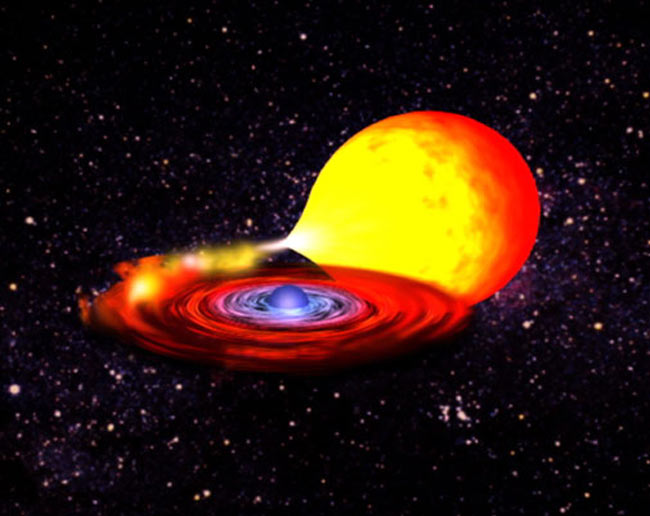NASA Predicts Huge Cosmic Explosions

Astronomersare now able to predict when a certain type of star will let loose a powerfuleruption.
Theexplosions occur on a neutron star, a city-sized remnant of a giant star thatexploded in a supernova long ago and collapsed into a hyperdense ember. It nowsiphons material from a companion star while the two objects orbit each otherevery 3.8 hours.
Theneutron star has incredibly strong gravity, so it sucks in some of the gas fromthe companion star?s atmosphere. The gas spirals onto the neutron star, slowlybuilding up on its surface until it heats up to a critical temperature.Suddenly, the gas at one small spot on the neutron star?s surface ignitesa powerful explosion, and the flame quickly spreads around the entire star.
"Wefound a clock that ticks slower and slower, and when it slows down too much,boom! The bomb explodes," said team leader Diego Altamirano of the University of Amsterdam in the Netherlands.
Theexplosion appears as a bright flash of X-rays.
Thenew study was done using NASA?s Rossi X-ray Timing Explorer (RXTE) satellite.
Theneutron star produces about 7 to 10 bursts per day. These explosions releasemore energy in 100 seconds than our sun radiates in an entire week. The energyis equivalent to 100 hydrogen bombs exploding simultaneously over eachpostage-stamp-size patch of the dying star?s surface.
Get the Space.com Newsletter
Breaking space news, the latest updates on rocket launches, skywatching events and more!
Scientistshave observed thousands of similar bursts from about 80 different neutronstars, according to a NASA statement today. But until now, they had no way topredict when they would occur.
Asgas gradually builds up on the neutron star?s surface, the atoms that make upthe gas slam together to form heavier atoms in a process known as fusion.Sometimes, the fusion occurs in a stable and almost perfectly repetitivefashion, producing a nearly regular X-ray signal known as a quasi-periodicoscillation (or QPO for short). Think of the QPO as a clock that ticks withnear-perfect precision.
Scientistsexpect that the QPO clock should tick about once every two minutes (120seconds). This is what Altamirano?s team found when the astronomers observedthe system with RXTE. But the team also found that the QPO clock starts tickingslower and slower as gas builds up on its surface. Whenever it slows down toone cycle every 125 seconds, the neutron star lets loose a powerful explosion.
"Wecan predict when these explosions are happening," Altamirano said.
Thisdouble-star system is called 4U 1636-53 and is about 20,000 light-years away.Of course that means the "predictions" involve explosions thatactually occurred 20,000 years ago; the light is justnow arriving.
"It'san exciting discovery," adds Tod Strohmayer of NASA?s Goddard Space FlightCenter in Greenbelt, Md. Strohmayer is an expertin neutron stars who was not involved in this study. He notes that the tickingof the QPO clock depends on the size and weight of the neutron star.
"Itgives us a new tool to study these fascinating objects," Altamirano said.
- Video: Explosion on Cue
- The Strangest Things in Space
- Video: Getting Started in Astronomy
Join our Space Forums to keep talking space on the latest missions, night sky and more! And if you have a news tip, correction or comment, let us know at: community@space.com.

Space.com is the premier source of space exploration, innovation and astronomy news, chronicling (and celebrating) humanity's ongoing expansion across the final frontier. Originally founded in 1999, Space.com is, and always has been, the passion of writers and editors who are space fans and also trained journalists. Our current news team consists of Editor-in-Chief Tariq Malik; Editor Hanneke Weitering, Senior Space Writer Mike Wall; Senior Writer Meghan Bartels; Senior Writer Chelsea Gohd, Senior Writer Tereza Pultarova and Staff Writer Alexander Cox, focusing on e-commerce. Senior Producer Steve Spaleta oversees our space videos, with Diana Whitcroft as our Social Media Editor.










